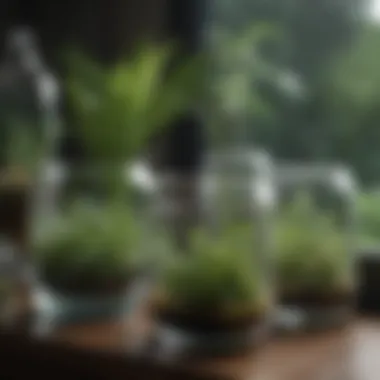Unlock the Secret: Mastering the Art of Growing Plants in Water


Gardening Know-How
When it comes to the art of nurturing plants in water, having a solid foundation in gardening know-how is essential. The key to keeping plants alive in a water-based environment lies in selecting the right species and understanding their unique requirements. Ensuring adequate sunlight, nutritional supplements, and proper grooming are crucial aspects of maintaining the health and vitality of water-grown plants. By following expert plant care guides and staying attuned to seasonal gardening tips, you can create a flourishing aquatic garden within your living space. Additionally, engaging in DIY garden projects allows you to personalize your water plant displays and enhance the aesthetic appeal of your home. By integrating these insights and practices into your gardening routine, you can cultivate a thriving oasis of greenery that adds a touch of nature's beauty to your indoor environment.
Introduction
Water propagation is a method of cultivating plants without soil, offering a unique way to enjoy greenery indoors. This article delves into the art of keeping plants alive in water, providing invaluable insights and tips on successfully nurturing greenery in a soil-free environment. From selecting the right plants to understanding essential maintenance practices, this guide aims to equip readers with the knowledge and skills needed to create thriving water-based plant displays in their living spaces.
Understanding Water Propagation
Benefits of Water Propagation
Water propagation presents a host of benefits for plant enthusiasts. One key advantage is the visibility it provides into root growth, allowing enthusiasts to witness the development of plant roots firsthand. This method also promotes easy monitoring of plant health, as any issues with root systems can be readily identified and addressed. Water propagation is particularly popular for its simplicity and low maintenance requirements, making it an appealing choice for both novice and experienced gardeners looking to expand their botanical horizons.
Types of Plants Suitable for Water Propagation
Certain plant species are better suited for water cultivation due to their natural adaptability to root development in aquatic environments. Plants like pothos, spider plants, and philodendron are excellent choices for water propagation due to their resilience and ease of rooting in water. These plants thrive in water, displaying impressive growth rates and robust root systems when provided with the appropriate care and conditions.


Selecting the Right Plants
Factors to Consider
When choosing plants for water cultivation, it is essential to consider factors such as light requirements, temperature sensitivity, and root structure. Plants that are adaptable to varying light conditions and do not require extensive root space are ideal candidates for water propagation. Additionally, selecting plants known for their ability to thrive in water environments enhances the success rate of water-based cultivation projects.
Popular Plant Choices for Water Cultivation
Popular plant options for water cultivation include pothos, lucky bamboo, and peace lilies. These plants are widely favored for their compatibility with water propagation and ability to flourish in water-filled containers. Their ornamental foliage and relatively low maintenance needs make them sought-after selections for indoor water gardens.
Preparing the Water Environment
Water Quality Standards
Maintaining optimal water quality is crucial for the health and growth of water-cultivated plants. Using filtered or distilled water helps reduce the risk of salt and mineral build-up, which can hinder root development and overall plant vitality. Regularly testing water quality and adjusting as needed ensures a stable environment for plant growth.
Container Selection


Choosing the right container for water cultivation is significant. Transparent vessels are preferred for water propagation, as they allow for easy monitoring of root development and water levels. Containers with wide openings facilitate plant placement and maintenance tasks, contributing to a seamless cultivation experience.
Planting Process
Step-by-Step Instructions
The planting process for water-based cultivation involves placing plant cuttings or roots in a container filled with clean water. Trim any excess leaves on cuttings to prevent decay and submerge the stems in water, ensuring the nodes are submerged. Position the container in a well-lit area away from direct sunlight to promote healthy root growth and overall plant development.
Tips for Successful Planting
To enhance the success of water-based planting projects, periodically change the water to prevent stagnation and the accumulation of harmful bacteria. Ensure containers are cleaned regularly to maintain water quality. Additionally, supplementing plants with liquid fertilizers at appropriate intervals provides essential nutrients for sustained growth and vitality.
Maintenance and Care
Changing Water Regularly
Regularly changing the water in plant containers is vital for preventing the build-up of algae, bacteria, and other harmful substances that can compromise plant health. Aim to replace the water every one to two weeks or as needed based on water quality indicators, ensuring a clean and conducive growth environment.


Providing Adequate Light and Nutrition
Proper lighting is essential for the photosynthesis process and overall plant well-being. Ensure water-based plants receive adequate indirect sunlight or artificial light sources to support healthy growth. Additionally, maintain a balanced nutrition regimen by introducing liquid fertilizers formulated for use in water-based plant systems, promoting robust development and vibrant foliage.
Common Issues and Troubleshooting
Root Rot Prevention
To prevent root rot in water-based plants, avoid over-watering and ensure proper drainage to prevent waterlogging. Monitor root health regularly, trimming any discolored or decaying roots to prevent the spread of disease. Maintaining a balanced watering schedule and providing adequate ventilation around the plant's root zone mitigate the risk of root rot occurrence.
Dealing with Pests
Pests can pose a threat to water-cultivated plants, requiring proactive measures for detection and control. Inspect plants regularly for signs of pest infestation, such as yellowing leaves or unusual spots. Introduce natural pest deterrents like neem oil or soap solutions to discourage pests and maintain plant health.
Benefits of Water-Based Plant Cultivation
Enhancing Indoor Spaces
Water-based plant cultivation enhances interior aesthetics by introducing vibrant greenery into living spaces. The visual appeal of water-grown plants adds a refreshing touch to home decor, creating focal points and promoting a serene ambiance. Incorporating water-based plants in interior design schemes contributes to a harmonious and natural atmosphere.
Promoting Plant Growth
The unique growing environment offered by water propagation stimulates robust plant growth and root development. Water-cultivated plants often exhibit accelerated growth rates and lush foliage, showcasing the potential of water-based cultivation methods in fostering healthy and thriving plant specimens. By promoting optimal growth conditions, water propagation facilitates the flourishing of botanical displays and encourages a deeper appreciation for plant cultivation.







